|
|
 |


July/August
2002
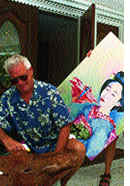 Showcasing
Talents Showcasing
Talents
Last October, artist Myra Roberts and her sculptor husband, Wes, had been
living in their Sanibel home barely a month when they embarked on a nearly
full-time volunteer project that lasted until spring.
Southwest Florida Symphony Society president Pam
Webber, a close friend of Myra since they were in high school together
near Chicago, sought their help with the society’s designer showcase.
The annual fund-raiser was set for February 2002 in a 7,000-square-foot
Sanibel home. Organizers invited interior decorators to showcase their
talents, as usual, but Myra had a brainstorm: “Why not have artists
be represented, too, in addition to the interior designers?”
The Robertses put in hundreds of hours on the project. They researched
Southwest Florida’s artists from Sarasota to Marco Island, and invited
60 artists—who readily agreed to donate 20 percent of any sale proceeds
to the Symphony Society—to exhibit at the showcase. Fifteen artists,
including Myra, sold their works through the showcase.
Since it ended, they have had more time for their
art and their family, which includes a son at The Sanibel School and a
daughter in high school, in addition to a grown daughter.
Myra, who taught art in Illinois schools for 26 years, once again is busy
painting. Working with acrylic, oil, or watercolor, she paints a broad
range of subjects, from food to history, often with a Japanese influence.
Her works can be seen at the Seaweed Gallery on Sanibel or Captiva.
Wes’s environmental interest is reflected in his sculptures, which
can be found at McEnroe Gallery on Sanibel. Retired after teaching high
school science for 31 years, he creates wood-and-metal or wood-and-marble
pieces; an alligator sculpture of his drew much admiration at the showcase.
The Robertses say the time and effort they spent
on the fund-raiser was well worthwhile. And their work seems to have set
a precedent: A Naples organization recently sought advice on how to include
artwork at its benefit showcase.
– Libby Grimm
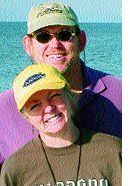 Rediscover
Sanibel and Captiva Rediscover
Sanibel and Captiva
Writing a travel guide to Sanibel and Captiva was a learning experience
for Sanibel residents Mike and Julie Neal. They learned more about their
community, about self-publishing a travel guide—and they’ve
learned that they really should have done it years ago. Had they known
what a rewarding experience it would be, Mike says, “our dream 20
years ago would have been to move to an island and write a travel guide.”
Seeking a community to raise their daughter, Micaela,
now 8, they moved to Sanibel in 1996 from Atlanta, where they had a publishing
company producing newsletters, media kits, and brochures for corporations.
For the first year, Julie commuted to Atlanta, which quickly grew old.
“I missed Micaela’s year in kindergarten,” she says.
So they searched for a solution. The Neals had
seen history and nature books about the islands as well as regional travel
guides, but they couldn’t find a travel guide specifically for Sanibel
and Captiva, and in her volunteer work at J.N. “Ding” Darling
National Wildlife Refuge, “I noticed how in the dark visitors were,”
Julie says.
On Christmas 2000, they decided to write and self-publish the guide. They
had never tackled a book, but they had the skills and the publishing background.
Julie, who has a background in art and photography,
and Mike, who studied journalism and had experience in sales, switched
roles. “My job was to walk the beaches and take pictures,” Mike
says. “Micaela was a big part of that.” (Notice the photo credit
in the book for the picture of the authors.) Julie took on the research
role and now is in charge of sales. They did the writing together, each
writing and then the other editing.
Julie started by surveying residents and visitors
to learn what the guide should include. (The No. 1 question: “Where’s
a good place to eat?”)
Even longtime residents can learn something from
the guide. Sanibel & Captiva: A Guide to the Islands is plenty informative,
covering everything from cultural and natural history to fishing, restaurants,
accommodations, and recreation. This photo-filled guide is also entertaining,
with such nuggets as “Top ten reasons to marry a shell collector,”
what children have to say about shelling, even a discussion of the fight
to bar McDonald’s from Sanibel.
The response to the guide, the Neals say, has been rewarding. “One
person said, ‘What I see in your book throughout is your love for
the islands,’ ” Julie says. “That pleased me so much.”
– Jill Tyrer
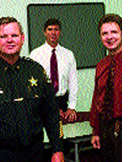 Investigate
the Sheriff’s Office Investigate
the Sheriff’s Office
Most Thursday evenings of the year, about 30 area residents voluntarily
show up at the Lee County Sheriff’s Office. No, they’re not
turning themselves in. They’re taking part in a free, ten-week Citizens
Academy Program.
Until recently, the academy was coordinated by
Capt. Bill Cameron, whom many islanders know as Captiva’s former
resident deputy. Six years later, he says with a laugh, “I never
miss an ABC sale.”
Cameron, who has lived in Lee County since 1973,
worked for five years with the Ft. Myers Police Department before joining
the Sheriff’s Office 15 years ago. On Captiva, he was responsible
not only for Captivans, but for responding to emergencies on North Captiva,
Useppa, Cabbage Key, and Cayo Costa.
“It was extremely unique work that was truly
a 24/7 job,” he says. “Working on the islands is community policing
at the highest level—knowing everybody, and everybody knowing you.
To hear him talk, a similar sense of friendship
and community develops among those who go through the Citizens Academy,
which he coordinated for the past two years. “The program is so successful
and innovative that people just love it. At the end of ten weeks, they
don’t want to leave,” he says. In fact, many “graduates”
join the Citizens Academy alumni organization and take part in volunteer
activities or advisory boards. “Once they’re here, they’re
family,” he notes.
Captiva residents Ron and Phyllis Gibson plan
to join the academy in September. Among the Gibsons’ numerous community
activities is Ron’s service as a volunteer firefighter with the Captiva
department, where Phyllis is a fire commissioner. His long-standing interest
in law enforcement—he even pursued becoming a deputy a few years
ago—and the fact that Phyllis wanted to go through the course made
it an easy decision when Cameron suggested they join the academy. “It
makes you appreciate what the Sheriff’s Office does,” Ron says.
Cameron has been promoted to “drug demand
reduction coordinator,” so he no longer heads up the academy, but
that doesn’t seem to have diminished his enthusiasm for the program.
“This educational and interactive program gives participants a look
at the inner workings of the Sheriff’s Office, including 911 dispatch,
road patrol, SWAT, and the Aviation Unit, to name a few.” Optional
activities on three Saturdays include visiting the stockade on Ortiz Avenue,
the firing range, and a driving course. Participants also go on road patrol.
“You ride shotgun and take whatever comes that shift,” he explains.
“It’s fun, educational, interesting,
exciting,” Cameron says. “It’s not enough to sit in the
audience; we want you to experience it.”
For more information, call 239/477-1400.
– Libby Grimm
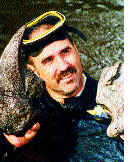 Digging
for Treasures Digging
for Treasures
Little kids love to dig. To them, a hole in the ground opens up endless
hours of fun and discovery. Eventually, most leave the unfilled holes
and move to other pursuits as they make their way to adulthood. But for
Lehigh Acres resident Mark Renz, a 40-something-year-old Florida native,
grubbing in the dirt is all in a day’s work and a hole in the ground
still represents fun and discovery. Renz and his wife, Marisa, own and
operate Fossil Expeditions (www.fossilexpeditions.com).
Calling it a “hobby that got out of control,”
Renz marks the beginning of his obsession with a bad day of fishing with
his brother. “We were on the Caloosahatchee River. It was a slow
day, so we pulled to the shore. We looked around and I found a whale’s
ear bone. I was hooked.”
Renz left Florida for a time to pursue a career
in Nashville as a county and western songwriter and followed other career
paths such as newspaper reporting, public relations, and ecotour guiding.
But he spent every spare moment fossil collecting along rivers, creeks,
and phosphate mines. He finally parlayed his avocation into a successful
business and has written two books illustrated by Marisa, a commercial
artist.
University Press of Florida published his first
book, Fossiling in Florida: A Guide for Diggers and Divers. With his second,
Renz took another turn in his career path. “I decided it was time
to start my own small publishing company, PaleoPress,” he says.
While Fossiling in Florida is a general guide
for amateur fossil hunters, in his newly released Megalodon: Hunting the
Hunter, Renz focuses on the enormous prehistoric shark C. megalodon, “Meg”
for short. Renz says that although he has led searches for the bones and
teeth of many prehistoric animals, “none elicit as much intrigue
and excitement as teeth from the largest and most fearsome shark ever
to inhabit our seas.” With teeth that can be up to 7 inches long,
he explains, “There is something about uncovering a tooth of this
40- to 60-foot aqua-motive that sets the imagination on fire.”
– Trudi Edelman
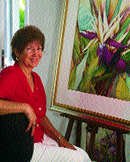 Floral
inspiration Floral
inspiration
Doris Schroeder will happily tell you about her passion for tropical flowers,
but you won’t need her to if you’ve seen her watercolors—multi-hued
birds of paradise, hibiscus in shades of reds, sea grapes dangling in
a delicious clump among finely-veined leaves.
She and her husband, Gerhard, were living in Mexico
City in the 1970s when Doris started studying art. When they moved to
Southern California, she adopted her medium of choice—watercolor.
“It’s so fascinating, so serene. The transparency is so beautiful
in watercolor, especially in the subjects I paint, tropical flowers,”
she says, her voice still musical with a German accent despite 30 years
in the United States. “With watercolor you can just let it flow,
the color flows.”
Later, living in Puerto Rico, she discovered her subject of choice. “I
fell in love with the tropical flowers and all the colors in Puerto Rico,”
she says. “Tropical flowers are so fascinating and beautiful, colorful.
I had seen them, of course, in Mexico, but not like in the Caribbean.
In Puerto Rico it was breathtaking.”
Many of her favorite flowers now grow at her home,
like the white bird of paradise that has become her signature. “I’ve
painted this white bird of paradise at least 25 times. Every time I see
a new flower, I have to paint it,” she says with a laugh. “There
are so many colors in it if you look close.”
In the tidy studio in her Cape Coral home are
some of her other works—mixed-media collages accentuated with metallic
hues and bits of palm fronds, or watercolors that she lets run, creating
patterns that she enhances—flowers blooming from the medium.
Schroeder’s works have been shown in the
Netherland Antilles, Puerto Rico, Germany, New York—where she sold
her first work, a hibiscus to a man from Hawaii—as well as in Miami.
Locally, her works can be seen in Gallery One in Naples, Seaweed Gallery
and McEnroe Gallery on Sanibel, and Wild Child Gallery at Matlacha.
Each work is a labor of love. “It takes a
long time to finish a painting,” she says. “My heart is in every
painting.”
– Jill Tyrer
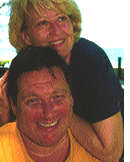 An
International Couple An
International Couple
Time spent with Gichi and Roxinne Savoretti is always enlightening. Truly
an international couple, they live in one of the world’s most beautiful
spots, Portofino, Italy, but rave about life on Sanibel and Captiva.
Their first visit to the islands was 14 years
ago, stopping while en route to Grenada. “Good memories brought us
back,” says Gichi. Roxinne embellishes, “It’s tropical,
it’s natural, and yet it has all the amenities of civilization.”
In addition, Gichi adds, “It’s made
a big difference to have friends here.”
The well-traveled couple met in Russia, where
the Savoretti family had a business representing foreign companies in
Russia. “I grew up in Genoa but moved to Moscow in 1978 to join the
business,” says Gichi. “I inherited it later and was an Italian
businessman living abroad when I ran into Roxinne and fell in love.”
And why was a Minnesota gal hanging out in Russia during the Cold War?
“I was working as a journalist with the Associated Press and was
sent to Moscow in 1980,” explains Roxinne. She was promoted to bureau
chief during her tenure in Moscow, but being romanced by Savoretti seems
to have been the highlight of her time in Russia.
“We are a match made in Moscow,” she
says with a laugh. “We’ve been there—from Brezhnev to Burger
King.”
The two left Russia permanently last year. “We
just had enough,” says Gichi. “Twenty years of cold winters
and bleak atmosphere, and we decided it was time for a change of life.”
Now the two travel between family residences in Lugano and Portofino,
where Roxinne has learned enough Italian to converse. Although she and
Gichi speak English at home, he is now focused on the Spanish language,
which he uses successfully in his new career selling insurance to cargo
and aviation companies. Savoretti saw opportunity in South America while
visiting a friend; he now has clients in Argentina, Uruguay, Chile, and
Brazil.
For all their activities, the two remain focused
on but a few goals: “I’d like a good harvest of olive oil in
the fall,” says Roxinne, of their hillside groves. The Savorettis
also dream of building a house on Sanibel in the not-too-distant future,
having already purchased a lot.
“This is like coming home,” says Roxinne.
“Having been uprooted from our original things, this is the place
that both of us like the most in the world. Here is where we’re really
happy, and where we want to be.”
– Libby Boren McMillan
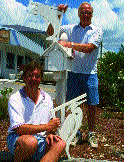 Marketing
a Corner Marketing
a Corner
When local cartoonist Dave Horton’s mailbox fell apart, a great idea
came together. Observing the single-post support beneath the mounted mailbox,
Horton’s creative mind shifted into gear. The result is Corner Creations,
fanciful brackets that reflect natural island elements and turn an ordinary
mailbox into art. The designs fill the right angle under the cross support
that holds the mailbox.
Horton and brother Lee pen the weekly “Too Much Sun” cartoon,
illustrated Sanibel Island’s Own Cartoon Book, and run their business,
Sanibel Print & Graphics Inc. On the Corner Creations project, Dave
partners with Clyde Carmain, his father-in-law.
Pointing out that wood wouldn’t last very long in the Florida climate,
Carmain insisted the brackets be made of PVC. “We both talked about
which designs to do and I drew ’em up,” Horton says. “He
cut ’em out.”
Corner Creations designs include a dolphin, heron, seahorse, and—the
most popular—a palm frond. They also offer a mailbox shaped like
a beach house and a custom bracket.
– Libby Boren McMillan
|

